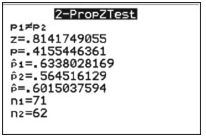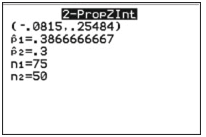Reference no: EM132338000
Inferences about Two Population Proportions Assignment -
Q1. In a recent survey, the following question was included: "How many tattoos do you currently have?" Of the n1 = 1200 males surveyed, x1 = 180 responded that they had at least one tattoo. Of the n2 = 1100 females surveyed, x2 = 140 responded that they had at least one tattoo. Use a hypothesis test at the level α = 0.05 to test whether there is a difference in the population proportions of men and women who had at least one tattoo.
(a) Write the null and alternative hypotheses.
(b) Find the sample proportion of males in the survey who reported having at least one tattoo: p ^1 =
Find the sample proportion of females in the survey who reported having at least one tattoo: p ^2 =
(c) Using the 2-PropZTest on your calculator, find the value of the test statistic.
(d) Give the p-value.
(e) State your decision.
(f) State your conclusion about the population proportions.
(g) Use the 2-PropZInterval to construct a 95% confidence interval for the difference in proportions. Then interpret it using the template on the notes page. (Remember the 2nd sentence because there are 2 samples).
Q2. On April 12, 1955, Dr. Jonas Salk released the results of clinical trials for his vaccine to prevent polio. In these clinical trials, 400,000 children were randomly divided in two groups. The subjects in group 1 (the experimental group) were given the vaccine, while the subjects in group 2 (the control group) were given a placebo. Of the 200,000 in the experimental group, 33 developed polio. Of the 200,000 children in the control group, 115 developed polio.
Follow the instructions below to perform a hypothesis test on whether the polio vaccine was effective. Use the significance level α = 0.01. Since group 1 received the polio vaccine, and group 2 received the placebo, and we expect the vaccinated children to get polio LESS often, the hypotheses are
H0: p1 = p2
H1: p1 < p2
(a) Using the 2-PropZTest on your calculator, find the value of the test statistic.
(b) Give the P-value. (This value is very small; you may use scientific notation)
(c) State your decision
(d) State your conclusion about the proportions of kids that contract polio.
Q3. Interpret calculator display: The following TI-84 Plus calculator display presents the results of a hypothesis test for the difference between two proportions. The sample sizes are n1 = 71 and n2 = 62.

a. Is this a left-tailed test, a right-tailed test, or a two-tailed test?
b. What is the P-value?
c. What is the decision at the α = 0.05 level?
Q4. Interpret calculator display: The following TI-84 Plus calculator display presents a 95% confidence interval for the difference between two proportions.

a. Compute the point estimate of p1 - p2.
b. Fill in the blanks: We are 95% confident that the difference between the proportions is between _____________ and _______________.